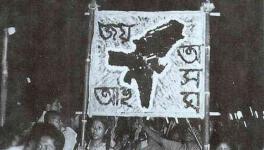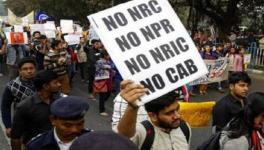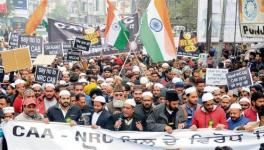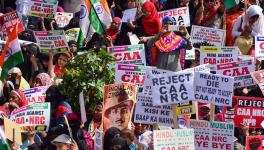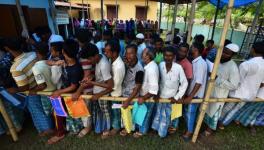What's Common to Kashmir and Assam? Doubting the Muslims
On August 5, the Narendra Modi government read down Article 370 of the Constitution and changed the status of Jammu and Kashmir (J&K) from state to Union Territory. These breathtaking measures have been justified as vital for vanquishing the secessionists and dampening the spirit of those who support them.
In the popular imagination, the Indian state cannot, obviously, countenance the Kashmiri Muslims leaving the Union. They have to be compelled to stay in India, on the terms the state decides upon.
The situation in Assam is opposite to that of Kashmir.
Assam is said to have been reeling under the illegal infiltration of Bangladeshis. It was to identify these people that a mammoth exercise was undertaken to update the National Register of Citizens (NRC) for Assam, the final list of which was published on August 31. Some 19.06 lakh people were excluded from it.
In the popular imagination, the Indian state cannot, obviously, host and feed illegal immigrants who have allegedly also diluted Assam’s cultural identity. They must be compelled to leave India, or corralled in detention centres, or disenfranchised as well as denied the right to own property, regardless of whether they are Hindu or Muslim.
The Bharatiya Janata Party (BJP), however, argues that Hindus fled Bangladesh because of religious persecution; that they are asylum-seekers in India and should be neither incarcerated nor deported, but granted citizenship. The BJP has articulated its idea through the framing of the Citizenship (Amendment) Bill, which hasn’t been passed yet.
The tragic irony linking Kashmir to Assam has emerged out of BJP’s hypocritical policies in those two states. At its nub is the party’s gnawing doubts about the loyalty of Muslims to India.
The doubts about the loyalty of Kashmiri Muslims to India date back to Partition and Independence. It was the Dogra ruler Hari Singh who had vacillated between joining India or Pakistan; the two succeeding states to which the British transferred power. Hari Singh acceded to India on October 26, 1947, fearing that the invasion of Jammu and Kashmir by tribesmen who had the Pakistan Army’s support, would deprive him of his kingdom. Only India could act as bulwark against them, he rightly thought.
On October 27, Lord Mountbatten, the Viceroy, wrote a letter to Hari Singh accepting the accession of Kashmir to India. Mountbatten, however, also noted that it is his government’s wish that “as soon as law and order have been restored in Kashmir and her soil cleared of the invader, the question of the state’s accession should be settled by a reference to the people.” This was reiterated by then Prime Minister Jawaharlal Nehru in his address to the nation on November 2.
As Pakistani tribesmen pushed towards Srinagar, they looted, killed and raped regardless of the religious identity of their victims. The invaders began to be evicted as Indian troops arrived in Srinagar, a day after Hari Singh acceded to India. Providing assistance to the Indian Army was Kashmir’s foremost leader, Sheikh Abdullah.
About the role of Kashmiri Muslims during the invasion, historian Radha Kumar writes in Paradise at War: A Political History of Kashmir, “Uri was jointly rescued by Indian troops and National Conference [Abdullah’s party]. Appointed ‘emergency administrator’ for Kashmir on 30 October, Abdullah rallied his cadre to defend the valley against the invaders. The National Conference’s support for the Indian Army was another shock to the Pakistani government.”
It was a shock because the Pakistanis assumed that the Kashmiri Muslims would identify with them because of sharing the same religion.
Kashmir’s accession to India was never referred to its people as Pakistan did not vacate territories of the state it had captured. Yet the idea of plebiscite, or self-determination, to decide whether the Kashmiris wanted to join India or Pakistan was subsequently expanded to include the third option of independence.
This was, to a great extent, because Kashmir’s foremost leader, Sheikh Abdullah, who was opposed to Jinnah’s two-nation theory, became nervous as the Praja Parishad and the Bharatiya Jana Sangh, the BJP’s earlier incarnate, launched a campaign for “One Constitution, one head of state, and one flag” in 1951. It was around this time that Abdullah is said to have begun thinking of independence, which was why he was incarcerated in 1953.
In 1965, Pakistani troops and guerrillas, once again, slipped into Kashmir in the hope of fomenting a rebellion. Their expectations were belied. As Kumar notes, “Though some Plebiscite Front [formed by Mirza Afzal Beg, who was Abdullah’s trusted lieutenant] cadre joined the invaders, the party kept its distance and the general public of the valley did not rise in revolt. On the contrary, many in the valley caught and handed over Pakistani guerrillas to local police or Indian security forces.”
The valley’s opposition to Pakistan during the 1947 and 1965 invasions seems incredible today. The turnaround has happened because the Indian state’s persistent suspicion of the Kashmiri Muslims has alienated them. Election after election in the state was rigged, pliant chief ministers were planted in Srinagar, and Article 370 was gradually hollowed out to erode J&K’s autonomy.
A section in Kashmir has always opposed its accession to India. But their numbers grew exponentially after the 1987 Assembly election, which was brazenly manipulated and widely regarded to have been the immediate cause of the rise of the militant movement. The Valley bled, both because of militants and the Indian security forces.
Kashmir needed a healing touch. Instead, the government’s August 5 measures seek to frighten the Kashmiris into submission and mock their quest for autonomy. The message to the Kashmiri Muslim is unequivocal—abandon the idea of self-determination and independence. There is no getting away for him or her from being Indian.
In contrast to Kashmir, Assam’s identity was constructed around the Assamese language. This project dates to the early 19th century, when the British annexed Assam after signing the 1826 Treat of Yandabo with Burma. The colonial rulers brought educated Bengalis to Assam for overseeing its governance and peasants to reclaim land for cultivation. An intense competition ensued between the Bengalis and the Assamese, who sought to develop their language and, from the 1890s, began to increasingly express their fears that their culture and identity being diluted.
The peasants who were brought to bring the land in Assam under cultivation were largely Muslim and Bengali-speaking. Yet “the immigrant Muslims embraced Assamese, setting up schools to teach their children Assamese,” observes Abdul Mannan, a retired professor of statistics, in his book, Infiltration: Genesis of Assam Movement. These Muslims came to be known as neo-Assamese.
Assamese leaders did not perceive Muslims as a threat because they—freedom fighter and litterateur Ambikagiri Raichoudhury for instance—believed they were too poor to be able to sustain their culture and would, ultimately, become assimilated in the Assamese society.
Yet their attempts to assimilate with the Assamese society came to naught. Assam’s first chief minister, Gopinath Bordoloi, adopted and ruthlessly implemented the Immigrants (Expulsion from Assam) Act, 1950, which allowed the government to expel persons who were deemed unsafe for Indian citizens. Thousands of Muslims were said to have been driven out, their land and houses appropriated by Bengali Hindus who had migrated from East Pakistan.
Likewise, an estimated six lakh Muslims were expelled between 1962 and 1969 under the PIP (Prevention of Infiltrators of Pakistani Nationals into India) Scheme introduced by the government of Assam Chief Minister Bimala Prasad Chaliha.
About the PIP scheme, Mannan writes, “The police used to pick up people from bed at night and transport them to the border the next morning. The arrested people were not granted an opportunity to prove their citizenship.”
Assam witnessed another wave of migration during the months preceding the birth of Bangladesh in 1971 – and thereafter. This was to trigger a powerful movement in Assam, in 1979, against illegal immigrants. Bengali Muslims became synonymous with illegal immigrants, not least because of the Rashtriya Swayamsevak Sangh’s concerted efforts.
It had always seemed a remote possibility that Muslims constituted the bulk of illegal immigrants in Assam. For one, Bangladesh’s Hindu population declined from 18%-19% in 1971 to 8%-9% today. For Hindus leaving that country, Assam was one of their destinations, more so the Barak Valley, where its predominant Bengali milieu was an attraction. For the other, as Mannan has shown in his book, the rise in the population of Muslims in Assam is largely due to their high fertility rate, which is a function of their poverty and illiteracy.
Mannan has been cited in a recent piece on the NRC by noted scholar and literary critic Hiren Gohain, who notes that the BJP “leaders are particularly upset at it [NRC] has belied their hopes of netting a huge number of immigrant Muslims in a dragnet—reportedly, a majority of those left out [of the NRC] are Hindus.” BJP leaders have taken to describing the NRC as error-ridden and criticising its figure of exclusion only because it doesn’t match the myth their imagination has spawned.
Their imagination has been fuelled by their belief that Muslims can’t be loyal to India, and the best course for India’s security is consequently to police them severely, as in Kashmir, or to declare them as foreigners, as in Assam. The BJP’s hypocrisy links the Muslims of Kashmir to those in Assam and will, quite sadly, alienate them from the Indian state.
Ajaz Ashraf is a freelance journalist in Delhi. Views are personal.
Get the latest reports & analysis with people's perspective on Protests, movements & deep analytical videos, discussions of the current affairs in your Telegram app. Subscribe to NewsClick's Telegram channel & get Real-Time updates on stories, as they get published on our website.













